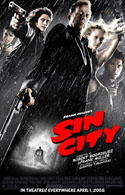Sin City is the kind of movie you have to talk about. The kind of movie you can’t shut up about. Whether or not you like it, it’ll ignite a burning desire to share what you’ve seen with others. I rushed home from watching it to write this, my way of getting this noir explosion out of my system. Not that I’m quick to be rid of it, but there’s no way I’ll be able to sleep without telling all of you about it.
I went in to it with absolutely no expectations. In fact, I was a little bit skeptical. I’ve never read the Frank Miller comic on which it was based (and still don’t plan to), but Rodriguez's almost slavish devotion to putting nothing but exactly what’s in there panel for panel up on screen scared me. So determined was he to bring the book to theaters exactly as is, Robert Rodriguez hired “Sin City’s” creator Frank Miller as a co-director. That kind of straight adaptation from book to screen is almost never successful, since film is a visual medium. But then this isn’t a novel they’re adapting, it’s a comic book. That’s a visual medium too. So perhaps that’s why unlike other such overly devoted translation attempts (Harry Potter 1 & 2 anyone?) Sin City is a shocking, revolutionary success.
The city lives up to its name. Vile, corrupt, and rotting from the inside out, this is someone’s vision of hell made real. The city is filled with murderers, thugs, rapists, and death. Violence is a way of life in Frank Miller’s world, and so the film itself is filled to the brim with it. Some may find it difficult to take. Though the black and white stylized look of the movie softens some of its more brutal blows, the bloodshed is laid on so thick it’s almost palpable. But I’m getting ahead of myself. Sin City is three separate stories held together by a few common threads. Three characters live in this city, and in their own, sometimes utterly twisted ways try to bring justice to a wasted, fetid world.
We begin with Bruce Willis’ Hartigan, a sure sign that Willis is eternally type cast, since he’s again playing a beaten down, honest cop on his way to retirement. Willis of course slips into the role almost effortlessly, and though we’ve seen him take on this type of character before, Sin City makes it impossible to be tired of it. Hartigan’s journey is the most pure of the three. He’s a genuinely good man, probably the city’s last honest cop. His struggle to do the right thing puts him through hell, and while unlike the others his story isn’t one of failed redemption or vengeance, it’s about something much more complex. Basic nobility, righteousness, maybe even love. He’s fighting to protect Nancy (Jessica Alba), a skinny stripper who in an odd choice by Rodriguez doesn’t take her clothes off. For the rest of its running time, Sin City doesn’t shy away from nudity. Carla Gugino has an extensive and artistically beautiful full nude scene, and deserves credit for being brave enough to do what was needed. So does Bruce Willis, though his is heavily shadowed. But Jessica Alba refused to take off her clothes and I think her character suffers for it. Rodriguez claims it was his decision (but then every director says that), but I’m not inclined to believe it. There’s something awkward about a girl surrounded by depravity dancing in the middle of a strip joint with her clothes on. It’s like a piece that doesn’t fit in an otherwise no holds barred story of chronic urban rot. Refusal to do nudity aside, Alba’s acting isn’t exactly up to snuff either. Surrounded by stellar, big name veteran performers, she comes off weak and hesitant. I never really got a good feel for Nancy Callahan, except to note that she frequently looks lost. Is that Alba out of her depth, or is her character really that chronically confused?
From Hartigan on, the movie mixes and matches stories, told sometimes in sequence, sometimes out. We meet Marv (Mickey Rourke), an obviously brutish thug with a hideous face and mental problems that require pills, pills which he hasn’t taken in days. He’s spurred on to seek justice through a simple act of kindness. No one has ever been so kind to him, and when Goldie is, it changes him. He tries to avenge her death the only way he knows how, by bringing death to others. Some of them are innocent. Marv knows it, but can’t stop. It’s Mickey Rourke that makes Marv’s tale Sin City’s strongest, most affecting story. Coated in freakish prosthetics and viciously murdering his way through the city, he makes Marv a sympathetic and layered character, though he spends a lot of time sawing off heads. His story is one of twisted, unnatural redemption: A psychotic killer trying to redeem himself by slaughtering the right people. He’s so natural; Rourke slips into the role like it’s a second skin. He steals the movie, it’s the role he was born to play and Mickey tackles it with relish.
Dwight’s (Clive Owen) story is a little more complicated. We never know who or what the man has been; only that he’s not someone to be messed with. He befriends a waitress and becomes entangled with her old abusive boyfriend named Jackie Boy (Benicio Del Toro). Things go poorly, and with the help of the hookers in Old Town Dwight makes Jackie Boy very very dead. Big mistake. They’ve killed the wrong man and risk open war between Old Town’s vicious, independently run whores and the pimps, gangs, and thugs who used to run their little section of purgatory. Dwight fights to save his slut friends, and in doing so terminates a lot of Irishmen. Clive is battered and beaten looking here, his face lined with shadow, a caricature of hard living. His bright red Converse sneakers stand out amidst the darkness, a brutal black and white killer with brightly colored shoes.
Sin City is an amazing, innovative, new way of storytelling using technology we’ve seen botched into boredom in movies like Sky Captain and both the dubiously enjoyed Star Wars prequels. Those movies used green screen and digital moviemaking for cool special effects. Rodriguez is using it to say something. The film is black and white, the actors are real, everything else is not. Color splashes onto the screen at all the right moments. When Josh Hartnett talks about the beauty of a woman’s eyes, they flare green with color. When he talks about the calm storm inside her, the shadows around her face stir ever so slightly with the colors of an impending storm. When Nancy dances, she lights up with flushed hues, sparkling with light as the men of Sin City ogle her. The result is marvelous, a perfect use of special effects to bring balls to the wall acting and atmosphere together in a dark, multi-layered narrative. It’s as if through technology real film noir has been resurrected, with a disturbed, hyper-violent twist.
I know I keep mentioning it, but people need to be clear on this before going in: Violence is what Sin City is. Because it is so stylized and mostly in black and white the violence isn’t necessarily gruesome, but it is prolific. Every shot of the film is filled with killing, and hatred, and death. Don’t get me wrong, it’s not gratuitous. The violence is essential, but omnipresent. Some people won’t be able to take it. Though I love this film, if that’s you, stay away.
If you can take what’s being thrown at you, Sin City is an incendiary movie experience. You’ve never seen anything like it. This is easily Rodriguez best movie, and it bears comparison to Tarantino’s (who guest directed a Sin City scene) Kill Bill masterpiece. Both are deeply personal tales of ultra-violence that blast so much originality on screen it’s almost impossible to take. It’s a perfect use of a so far wasted technology, a perfect adaptation of a visceral source material into a movie that succeeds beyond expectation. The cast is utterly amazing, and I’ve only touched on a few of the main characters here, but every big name brings something incredibly special to their role. Elijah Wood is flat out freaky as a quiet little psycho with glasses, Nick Stahl is disturbed as a yellow skinned killer, Rosario Dawson works the hell out of her mohawk, and if you sniff her I bet Jaime King actually does smell like angels. Sin City is fierce and unafraid, an assault on your senses and a dark, harsh tale in which characters struggle to do what’s right by doing wrong. It’s not bright or cheery and there are no happy endings, but what‘s here is shockingly beautiful.











